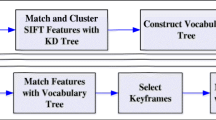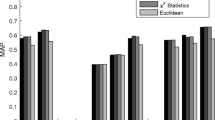Abstract
Typical content-based image retrieval systems retrieve images based on comparison of low-level features such as images color, texture, and shapes of objects in the images. Further, the image covariance descriptor (CD) and the image Patch Relational Covariance Descriptor (PRCD) can be used to summarize low–level features and the visual arrangement to improve the precision of the retrieval. Nonetheless, comparing images based on those two descriptors is computationally expensive. Therefore, this research proposes a clustering method that dynamically groups database images using the Minimum Spanning Tree Clustering algorithm (MSTC). The technique is named Representative Images from Minimum Spanning Tree Clustering (RIMSTC). In the proposed technique, only the representative images selected from each cluster are compared with the input image . Experimental results demonstrated that the proposed representative images by COV and PRCD combined with RIMSTC helps to improve the retrieval time while maintaining comparable retrieval performance to existing methods.























Similar content being viewed by others
References
Bank D, Koenigstein N, Giryes R (2020) Autoencoders. Machine Learning (cs.LG); Computer Vision and Pattern Recognition (cs.CV); Machine Learning (stat.ML)
Bay H, Tuytelaars T, Van Gool L (2006) Surf: speeded up robust features. Comput Vis-ECCV 2006 3951:404–417. https://doi.org/10.1007/11744023_32
Cao Z et al (2021) Multi-modality fusion learning for the automatic diagnosis of optic neuropathy. Pattern Recogn Letters 142:58–64. https://www.sciencedirect.com/science/article/pii/S0167865520304402. https://doi.org/10.1016/j.patrec.2020.12.009
Chen T et al (2021) Discriminative cervical lesion detection in colposcopic images with global class activation and local bin excitation. IEEE J Biomed Health Inform PP
Chen J et al (2021) A transfer learning based super-resolution microscopy for biopsy slice images: the joint methods perspective. IEEE/ACM Trans Comput Biol Bioinforma 18(1):103–113. https://doi.org/10.1109/TCBB.2020.2991173
Deselaers T, Pimenidis L, Ney H (2008) Bag-of-visual-words models for adult image classification and filtering
Dokmanic I, Parhizkar R, Ranieri J, Vetterli M (2015) Euclidean distance matrices: essential theory, algorithms, and applications. IEEE Signal Proc Mag 32(6):12–30. 10.1109/MSP.2015.2398954
Dupret G, Piwowarski B (2013) Model based comparison of discounted cumulative gain and average precision. J Discrete Algorithm 18:49–62. https://doi.org/10.1016/j.jda.2012.10.002, selected papers from the 18th International Symposium on String Processing and Information Retrieval (SPIRE 2011)
Faulkner H et al (2015) A study of the region covariance descriptor. Impact of feature selection and image transformations
Feng R et al (2021) A deep learning approach for colonoscopy pathology WSI analysis: accurate segmentation and classification. IEEE J Biomed Health Inform 25(10):3700–3708
Graham R, Hell P (1985) On the history of the minimum spanning tree problem. Ann Hist Comput 7(1):43–57. https://doi.org/10.1109/MAHC.1985.10011
J A, R S (2022) A faster secure content-based image retrieval using clustering for cloud. Expert Syst Appl 189:116070. https://www.sciencedirect.com/science/article/pii/S0957417421014093. https://doi.org/10.1016/j.eswa.2021.116070
Jamshed M, Parvin S, Akter S (2015) Significant hog-histogram of oriented gradient feature selection for human detection. Int J Comput Appl 132:20–24. https://doi.org/10.5120/ijca2015907704
Kanagala H, Krishnaiah V (2016) A comparative study of k-means dbscan and optics
Karacan L, Erdem E, Erdem A (2013) Structure-preserving image smoothing via region covariances. ACM Trans Graph 32(6). https://doi.org/10.1145/2508363.2508403
Khunsongkiet P, Bootkrajang J, Techawut C (2020) Patch relational covariance distance similarity approach for image ranking in content–based image retrieval
Križaj J, Dobrisek S, Štruc V (2022) Making the most of single sensor information: a novel fusion approach for 3d face recognition using region covariance descriptors and gaussian mixture models. Sensors 22:2388. https://doi.org/10.3390/s22062388
Kruskal JB (1956) On the shortest spanning subtree of a graph and the traveling salesman problem. Proc Am Math Soc 7(1):48–50. https://doi.org/10.2307/2033241, full publication date: Feb. 1956
kumar Panda S, Panda CS (2019) A review on image classification using bag of features approach. Int J Comput Sci Eng 7:538–542. https://doi.org/10.26438/ijcse/v7i6.538542
Liao S, Law MWK, Chung ACS (2009) Dominant local binary patterns for texture classification. IEEE Trans Image Process 18(5):1107–1118. https://doi.org/10.1109/TIP.2009.2015682
Lindeberg T (2012) Scale invariant feature transform. Scholarpedia 7:10491. 10.4249/scholarpedia.10491
Liu Y, Zhang D, Lu G, Ma W-Y (2007) A survey of content-based image retrieval with high-level semantics. Pattern Recogn 40(1):262–282. https://www.sciencedirect.com/science/article/pii/S0031320306002184. https://doi.org/10.1016/j.patcog.2006.04.045
Liu Y, Zhang D, Lu G, Ma WY (2007) A survey of content–based image retrieval with high–level semantics. Pattern Recogn 40(1):262–282. https://doi.org/10.1016/j.patcog.2006.04.045
Lowe DG (2004) Distinctive image features from scale–invariant keypoints. Int J Comput Vis 60:91–110. https://doi.org/10.1023/B:VISI.0000029664.99615.94
Lu Y, Zhang L, Tian Q, Ma W-Y (2008) What are the high-level concepts with small semantic gaps?
Memar Kouchehbagh S, Suriani Affendey L, Mustapha N, Doraisamy SC, Ektefa M, Lukose D, Ahmad AR, Suliman A (2012) (eds) High level semantic concept retrieval using a hybrid similarity method. In: Lukose D, Ahmad AR, Suliman A (eds) Knowledge technology. Springer, Berlin, pp 262–271
Nguyen-Quoc H, Hoang VT (2021) A revisit histogram of oriented descriptor for facial color image classification based on fusion of color information. J Sens 2021:6296505. https://doi.org/10.1155/2021/6296505
Pachghare V (2016) Microservices architecture for cloud computing. J Inf Technol Sci 2:13
Peters G, Wilkinson JH (1970) Ax = lambda bx and the generalized eigenproblem. SIAM J Numeric Anal 7(4):479–492. https://doi.org/10.1137/0707039
Prim RC (1957) Shortest connection networks and some generalizations. Bell Syst Technic J 36(6):1389–1401. https://doi.org/10.1002/j.1538-7305.1957.tb01515.x
Rajinikanth V, Kadry S, Crespo RG, Verdú E (2021) A study on rgb image multi-thresholding using kapur/tsallis entropy and moth-flame algorithm. Int J Interact Multimed Artif Intell 7:163–171. https://doi.org/10.9781/ijimai.2021.11.008
Rakesh C, Sarma C, Jha M (2015) Document clustering using k-means and k-medoids
Russakovsky O et al (2015) Imagenet large scale visual recognition challenge. arXiv:1409.0575
Shikha B, Pandove G, Dahiya P (2020) An extreme learning machine-relevance feedback framework for enhancing the accuracy of a hybrid image retrieval system. Int J Interact Multimed Artif Intell 6:15–27. https://doi.org/10.9781/ijimai.2020.01.002
Sulic VS, Perš J, Kristan M, Kovacic S (2010) Histogram of oriented gradients and region covariance descriptor in hierarchical feature–distribution scheme. In: Proceedings of the 19th international electrotechnical and computer science conference (ERK2010) vol 2010. http://vision.fe.uni-lj.si/docs/danas/SulicERK2010FINAL.pdf
Tuzel O, Porikli F, Meer P (2006) Region covariance: a fast descriptor for detection and classification
Ulutagay G, Nasibov E (2008) Fn-dbscan: a novel density-based clustering method with fuzzy neighborhood relations
Wu H, Wu W, Peng J, Zhang J (2017) A novel image retrieval algorithm based on phog and lsh. International Journal of Computer Applications. aRTICLES YOU MAY BE INTERESTED IN Research on image retrieval algorithm based on LBP and LSH AIP Conference A Novel Image Retrieval Algorithm based on PHOG and LSH, vol. 1864, p. 20058, 2017. https://doi.org/10.1063/1.4992874
Xiao J, Xu H, Gao H, Bian M, Li Y (2021) A weakly supervised semantic segmentation network by aggregating seed cues: the multi-object proposal generation perspective. ACM Trans Multimed Comput Commun Appl 17:1–19. https://doi.org/10.1145/3419842
Yan K, Wang Y, Liang D, Huang T, Tian Y (2016) Cnn vs. sift for image retrieval. Alternative or complementary?
Yang X, Gao X, Song B, Han B (2021) Hierarchical deep embedding for aurora image retrieval. IEEE Trans Cybernet 51(12):5773–5785. https://doi.org/10.1109/TCYB.2019.2959261
Funding
The authors declare that no grants supported.
Author information
Authors and Affiliations
Corresponding author
Ethics declarations
Competing interests
Non-financial interests: No funding was received for conducting this study.
Additional information
Publisher’s note
Springer Nature remains neutral with regard to jurisdictional claims in published maps and institutional affiliations.
Piyavach Khunsongkiet, Jakramate Bootkrajang and Churee Techawut are contributed equally to this work.
Rights and permissions
Springer Nature or its licensor (e.g. a society or other partner) holds exclusive rights to this article under a publishing agreement with the author(s) or other rightsholder(s); author self-archiving of the accepted manuscript version of this article is solely governed by the terms of such publishing agreement and applicable law.
About this article
Cite this article
Khunsongkiet, P., Bootkrajang, J. & Techawut, C. Low-level feature image retrieval using representative images from minimum spanning tree clustering. Multimed Tools Appl 83, 3335–3356 (2024). https://doi.org/10.1007/s11042-023-15605-5
Received:
Revised:
Accepted:
Published:
Issue Date:
DOI: https://doi.org/10.1007/s11042-023-15605-5




